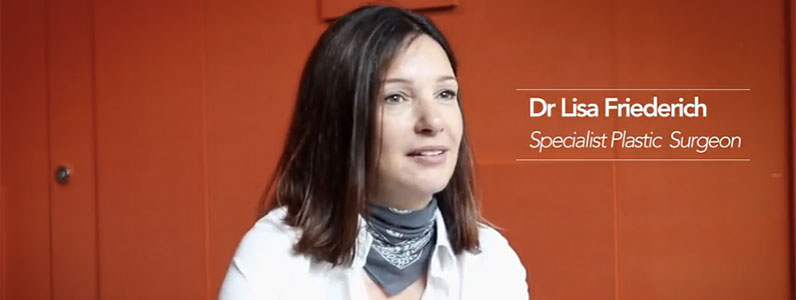
Hi, I’m Lisa Friederich. I’m a Specialist Plastic Surgeon based in Sydney.
Gender Surgery is a growing field. For Patients who are undergoing gender transition surgery, there’s a couple of different categories. Obviously female to male FTM , male to female MTF. I generally deal mostly with the female to male, and this involves plastic surgery… The surgery is separated into top surgery, which deals with masculinisation of the chest. And bottom surgery, which is a lot more complex in the female to male, and generally I’m not involved with that. That’s not really done very much in Australia.
In terms of the chest surgery, or the TOP surgery, the aim is to transform a female chest to a male chest. Just the obvious differences are the lack of a breast, but also the areola and the nipple are much smaller on a male, and they’re more laterally placed compared to the female. Then just in terms of looking at a chest, we define a breast by the crease underneath, or the inframammary fold. In a male chest that’s well muscled with a good definition of the pectoralis muscle, there’s a subpectoral fold, and that’s the sort of line that I aim to put a scar in if I need to put a scar there, just so that the eye is drawn to that rather than having it obscure the pectoral plane.
So the two sorts of surgeries are to do a scar around the areola, and we … This is sometimes called keyhole surgery, and it just allows mostly for an invisible scar as such. This is really only suitable for a very small breast. For any larger breast, they need to have a more sizeable scar because you need to remove excess skin. That’s where placing the scar underneath in the shadow of the pectoralis muscle just helps to disguise the fact that they’ve had a mastectomy, as such. So the surgery has evolved in gender patients, which have been growing, but also the massive weight loss patients and gynaecomastia. All those three areas use this sort of surgery, so it is still evolving, and people are continuing to refine how they do the operation.
The best results in all surgeries are when you’ve got a fit, healthy patient. From my perspective, it’s always easier to get a good result in someone who’s lean and has got good muscle bulk. So I always encourage my patients to work towards that.
There’s certainly … The testosterone is a very powerful hormone, and they will get facial hair in various degrees. I’ve not seen as many patients who have been on it for a long period of time, so I’m not sure of the effect. It certainly will deepen their voice. I’ve not seen the long-term effects on the face, but there are certain differences in the male face and the female face. Quite obviously, men have a stronger jawline. They have brow ridges. So there are surgical things that can be done to help that. The easiest and the simplest thing would be fillers to provide a more masculine appearance to the face. But it’s not an area that I’ve had that many inquiries for. It’s usually the other way around, men seeking feminisation surgery because once the men have gone through puberty and their face is changed, and those are quite powerful changes, so they generally need to have a fairly extensive surgical procedure to feminise them.
If anyone would like to make an appointment to speak to me about this, visit my PS Hub Profile
For more information about Gender Transition Surgery (previously known as Gender Reassignment Surgery or GRS))
- Male Rhinoplasty Gallery – Dr. Guy Watts Specialist Plastic Surgeon
- Perfect Breasts – The Pursuit of Aesthetic Excellence
- Male Breast Reduction Surgery Melbourne
- Female to Male FTM Top Surgery in Sydney by Dr Kernohan
- Male Breast Reduction Surgery for Gynaecomastia | My Klinik
- 8 Myths About Breast Reduction Surgery – Anca Breahna
